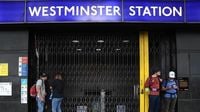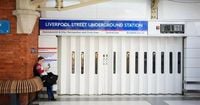Londoners awoke on September 9, 2025, to a city in gridlock, as nearly all London Underground services ground to a halt amid an escalating dispute between Transport for London (TfL) and the Rail, Maritime and Transport (RMT) union. The strike, which began on September 5 and is set to continue until September 11, has left millions scrambling for alternative ways to navigate the capital, as Tube workers walked out over pay, working hours, and broader working conditions.
Industrial relations on the Underground have “totally collapsed,” warned RMT union leader Eddie Dempsey, echoing the frustration and fatigue felt on both sides of the table. According to BBC reporting, Dempsey said negotiations broke down after the union uncovered what it described as TfL’s plans to shutter Elizabeth line ticket offices—a charge that TfL firmly denies. The dispute has also widened to include the pay and conditions of cleaners, with Dempsey cautioning that further conflicts loom if issues remain unresolved.
With the exception of the Northern line, which managed to run a reduced timetable, all Tube services were suspended on Tuesday, September 9. The Docklands Light Railway (DLR) was also brought to a standstill as RMT members staged a separate strike, adding to the chaos. Other TfL services, such as the Elizabeth line, London Overground, and trams, soldiered on but were quickly overwhelmed by the surge in demand. Commuters found themselves joining long bus queues, hopping into taxis, or even jogging and cycling to work—anything to avoid being stranded.
For many, the disruption was more than just an inconvenience. One woman, waiting outside Poplar DLR station in east London, told the BBC, “I have a kid who was affected. I couldn’t get her to school on time. I had to work. I got on three buses but I still couldn’t make it to work on time.” Another commuter shared that his usual eight-minute DLR journey turned into a 50-minute walk. “The weather is good, so no complaints,” he said, with a weary smile.
The impact of the strike rippled far beyond the platforms and tunnels. Tourists like Alessia Braida, visiting from abroad, found their plans derailed. “We are here from the 5th until the 12th, so exactly for the strikes. We are taking buses at the moment, but they’re either too full or stuck in traffic,” she explained to MyLondon. What should have been a quick 15-minute subway trip to Westminster Abbey became a 40-minute ordeal, if a bus could be boarded at all.
Disabled Londoners faced additional hurdles. Ash Gill, a 51-year-old commuter, described how minimized step-free access on the DLR forced him to use stairs, making his journey far more difficult. Yet, Gill expressed support for the industrial action, telling MyLondon, “I do agree with the strikes though, workers deserve to fight for better pay.”
As the city adapted, data revealed dramatic shifts in travel patterns. TfL figures showed that by 15:00 BST on September 9, Oyster and contactless payments across the network had plummeted 23% compared to the same day last year. Bus boardings were up 9%, London Overground journeys rose by 15%, and Elizabeth line usage jumped by a third. Cycle hire demand soared, with 22,805 hires recorded by 15:00—a staggering 73% increase over the previous week. Lime, one of London’s leading electric bike providers, reported brisk business. Hal Stevenson, Lime’s UK and Ireland policy director, told the BBC, “We knew it was going to be a challenging week.” Instead of deploying extra bikes, Lime focused on strategic placement and on-the-ground support in central areas, ensuring bikes were available where they were needed most.
Yet, not everyone could adapt so easily. Business owners, already reeling from economic pressures, braced for heavy losses. Prasanna Callaghan, owner of Crumpets Cafe in central London, told the BBC, “We will lose £600-£700 a day. One day might be bearable but it will be impossible to recuperate that total cost.” Muniya Barua, Deputy Chief Executive at BusinessLDN, warned that the strikes could cost the city millions, hitting hospitality, retail, and culture sectors especially hard. “At a time when the economy is weak and firms are already reeling from a National Insurance hike, the economic cost of these strikes could run into hundreds of millions of pounds. It also sends a really poor message to visitors and investors,” Barua said to The Standard.
The government, too, weighed in as frustration mounted. Downing Street called on RMT and TfL to return to negotiations and end the strike. The Prime Minister’s official spokesman told reporters, “I think Londoners will rightly be fed-up with the disruption from Tube strikes this morning—as parents try and drop their kids off at school, get to hospital appointments, get to work—and RMT and TfL need to get back around the table, work together to resolve this dispute in the interests of passengers.” The government’s Employment Rights Bill, they insisted, aims to foster a more constructive relationship with unions and a more secure workforce, distancing itself from what it called the “scorched earth” approach of previous administrations.
At the heart of the dispute are demands for a 32-hour working week—effectively a four-day week—and a 75% discount on nationwide train travel for TfL staff. TfL, for its part, has offered a 3.4% pay increase but rejected the shorter working week as “unaffordable.” Claire Mann, TfL’s chief operating officer, described herself as “bitterly disappointed” that the strike went ahead, calling the union’s demands “unaffordable and impractical.”
RMT officials, however, insist their proposals are reasonable and justified by the realities of the job. Jared Wood, RMT’s regional organiser for London, told the BBC, “It’s not something we enjoy doing, our members lose all their pay as well and we do have enormous sympathy for people going about their business.” He added, “People do 04:00 starts, 01:00 finishes… bank holidays are all normal working. People are exhausted and they want that issue addressed.” An RMT spokesperson further argued, “We are not going on strike to disrupt small businesses or the public. This strike is going ahead because of the intransigent approach of TfL management and their refusal to even consider a small reduction in the working week in order to help reduce fatigue and the ill health affects of long-term shift work on our members.”
Meanwhile, commuters’ patience is wearing thin. Chris Barnes, who travels from Ramsgate, Kent, saw his usual two-hour journey balloon to over three hours. “I accept the Tube workers are not happy and want change but this isn’t the way for that to be achieved. I understand they have issues but the millions of pounds of impact this will have, and lives that will be affected, means that my sympathy has run out for them,” he told the BBC.
As the strike continues, both sides insist they are open to negotiations, yet the gulf between their positions remains wide. With the city’s vital arteries clogged and tempers fraying, the coming days will test the resilience and patience of Londoners—and perhaps force a reckoning over the future of work on the Underground.



